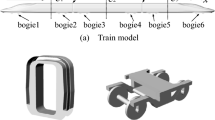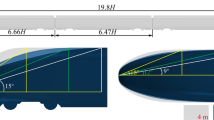Abstract
It is still difficult to conduct numerical calculation of the aerodynamic noise of full-scale, long-marshalling, high-speed trains. Based on the Lighthill acoustic analogy theory, the aerodynamic sound source of the high-speed train is equivalent to countless micro-vibrating sound sources. An acoustic radiation model of the dipole sound source of high-speed trains is established, and a method to predict the aerodynamic noise in the far field of long-marshalling high-speed trains is proposed. By this method, combined with numerical simulation technology, the flow field, noise source, and far-field noise characteristics of high-speed trains with different marshalling numbers are studied. The improved delayed detached eddy simulation method is used for flow field calculation, to obtain aerodynamic noise source information regarding the surface of high-speed trains. The numerical calculation method is verified by wind tunnel testing. The results show that the flow field and noise source characteristics of high-speed trains with different marshalling numbers are similar. The greater the length of the train body, the longer the trailing distance of the train wake, and the stronger of a surface noise source the tail car becomes. The spatial distribution characteristics of aerodynamic noise in the far field of high-speed trains do not change significantly with the length of the train body, but the magnitude of the sound pressure level will increase with the increase in length of the train body. The middle car body parts of high-speed trains with different marshalling numbers have similar noise distributions and sound pressure levels. Based on the noise calculation results of the 3-marshalling high-speed train, the far-field noise of the 5-marshalling and 8-marshalling train models is predicted and found to be in good agreement with the far-field noise of the actual train model. The differences in average sound pressure level are 1.01 dBA and 1.74 dBA, respectively.























Similar content being viewed by others
Data availability
The datasets used and/or analyzed during the current study are available from the corresponding author on reasonable request.
References
Cui YF, Tian C, Zhao ZY (2017) Research on the radiation characteristics of aerodynamic noises in the connection position of high-speed trains. J Vibroengineering 19(4):3099–3112
Cao Y, Li Z, Ji W, Ma M (2021) Characteristics analysis of near-field and far-field aerodynamic noise around high-speed railway bridge. Environ Sci Pollut Res 28(23):29467–29483
Dai WQ, Zheng X, Hao ZY, Qiu Y, Li H, Luo L (2018) Aerodynamic noise radiating from the inter-coach windshield region of a high-speed train. J Low Freq Noise Vib Act Control 37(3):590–610
Ffowcs-Williams JE, Hawkings DL (1969) Sound generation by turbulence and surfaces in arbitrary motion. Philosophical Transactions for the Royal Society of London. Series A, Math Phys Sci 264(1151):321–342
He B, Xiao XB, Zhou Q, Li ZH, Jin XS (2014) Investigation into external noise of a high-speed train at different speeds. J Zhejiang Univ-Sci A 15(12):1019–1033
He W, Zou C, Pang YT, Wang X (2020) Environmental noise and vibration characteristics of rubber-spring floating slab track. Environ Sci Pollut Res 28(11):13671–13689
Ikeda M, Yoshida K, Suzuki M (2008) A flow control technique utilizing air blowing to modify the aerodynamic characteristics of pantograph for high-speed train. J Mech Syst Transp Logist 1(3):264–271
Iglesias EL, Thompson DJ, Smith M, Kitagawa T, Yamazaki N (2017) Anechoic wind tunnel tests on high-speed train bogie aerodynamic noise. Int J Rail Transp 5(2):87–109
Jin XS (2014) Key problems faced in high-speed train operation. J Zhejiang Univ, Sci, A 15(12):936–945
Kim H, Hu Z, Thompson D (2020) Effect of different typical high speed train pantograph recess configurations on aerodynamic noise. Proc Inst Mech Eng Part F J Rail Rapid Transit 235(5):573–585
Lighthill MJ (1952) On sound generated aerodynamically. I. General theory. Proceedings of the Royal Society of London. Ser A, Math Phys Sci 211(1107):564–587
Li T, Dai ZY, Yu MG, Zhang WH (2021) Numerical investigation on the aerodynamic resistances of double-unit trains with different gap lengths. Eng Appl Comp Fluid 15(1):549–560
Li T, Qin D, Zhang WH, Zhang JY (2020) Study on the aerodynamic noise characteristics of high-speed pantographs with different strip spacings. J Wind Eng Ind Aerodyn 202:104191
Liu XW, Zhang J, Thompson D, Iglesias EL, Squicciarini G, Hu ZW, Toward M, Lurcock D (2021) Aerodynamic noise of high-speed train pantographs: comparisons between field measurements and an updated component-based prediction model. Appl Acoust 175:107791
Nagakura K (2006) Localization of aerodynamic noise sources of Shinkansen trains. J Sound Vib 293(3):547–556
Noh HM, Choi S, Hong S, Kin SW (2014) Investigation of noise sources in high-speed trains. Proc Inst Mech Eng Part F-J Rail Rapid Transit 228(3):307–322
Sassa T, Sato T, Yatsui S (2001) Numerical analysis of aerodynamic noise radiation from a high-speed train surface. J Sound Vib 247(3):407–416
Spalart PR, Deck S, Shur ML, Squires KD, Strelets MK, Travin A (2006) A new version of detached-eddy simulation, resistant to ambiguous grid densities. Theoret Comput Fluid Dyn 20(3):181–195
Shur ML, Spalart PR, Strelets MK, Travin AK (2008) A hybrid RANS-LES approach with delayed-DES and wall modelled LES capabilities. Int J Heat Fluid Flow 29(6):1638–1649
Sun ZX, Guo DL, Yao SB, Yang GW, Li MG (2013) Identification and suppression of noise sources around high speed trains. Eng Appl Comput Fluid Mech 7(1):131–143
Thompson DJ, Iglesias EL, Liu XW, Zhu JY (2015) Recent developments in the prediction and control of aerodynamic noise from high-speed trains. Int J Rail Transp 3(3):119–150
Wu JM (2016) Research on numerical simulation and noise reduction of aerodynamic noise in connection section of the high-speed train. J Vibroengineering 18(8):5553–5571
Wu J, Zou C, He S, Sun X, Wang X, Yan Q (2019) Traffic noise exposure of high-rise residential buildings in urban area. Environ Sci Pollut Res 26(9):8502–8515
Xiao YG, Yang Q, Sun L, Shi Y (2014) Longitudinal type-line optimization of high-speed train for low aerodynamic noise. J Central South Univ 21(6):2494–2500
Xiong XH, Yang B, Wang KW, Liu TH, He Z, Zhu L (2020) Full-scale experiment of transient aerodynamic pressures acting on a bridge noise barrier induced by the passage of high-speed trains operating at 380–420 km/h. J Wind Eng Ind Aerodyn 204:104298
Yu HH, Li JC, Zhnag HQ (2013) On aerodynamic noises radiated by the pantograph system of high-speed trains. Acta Mech Sin 29(3):399–410
Yue MT, Li H, Zhou X (2015) Analysis on aerodynamic characteristics and noise of the high speed train under high speed operation. J Vibroengineering 17(3):1452–1463
Yao YF, Sun ZX, Yang GW, Liu W, Prapamonthon P (2019) Analysis of aerodynamic noise characteristics of high-speed train pantograph with different installation bases. Appl Sci-Basel 9(11):2332
Zhu CL, Hemida H, Flynn D, Baker C, Liang XF, Zhou D (2017) Numerical simulation of the slipstream and aeroacoustic field around a high-speed train. Proc Inst Mech Eng Part F-J Rail Rapid Transit 231(6):740–756
Zhang YD, Zhang JY, Li T, Zhang L (2017) Investigation of the aeroacoustic behavior and aerodynamic noise of a high-speed train pantograph. Sci China Technol Sci 60(4):561–575
Funding
This work was supported by National Key Research and Development Program of China (2020YFA0710902) and National Natural Science Foundation of China (12172308).
Author information
Authors and Affiliations
Contributions
DQ and TL developed the idea of the study, participated in its design and coordination, and drafted the manuscript. ZD contributed to the acquisition and interpretation of data. TL and JZ provided critical review and substantially revised the manuscript. All authors read and approved the final manuscript.
Corresponding author
Ethics declarations
Ethics approval and consent to participate
Not applicable.
Consent for publication
Not applicable.
Competing interests
The authors declare no competing interests.
Additional information
Responsible Editor: Philippe Garrigues
Publisher's note
Springer Nature remains neutral with regard to jurisdictional claims in published maps and institutional affiliations.
Rights and permissions
About this article
Cite this article
Qin, D., Li, T., Dai, Z. et al. Study on prediction in far-field aerodynamic noise of long-marshalling high-speed train. Environ Sci Pollut Res 29, 86580–86594 (2022). https://doi.org/10.1007/s11356-022-21215-9
Received:
Accepted:
Published:
Issue Date:
DOI: https://doi.org/10.1007/s11356-022-21215-9




